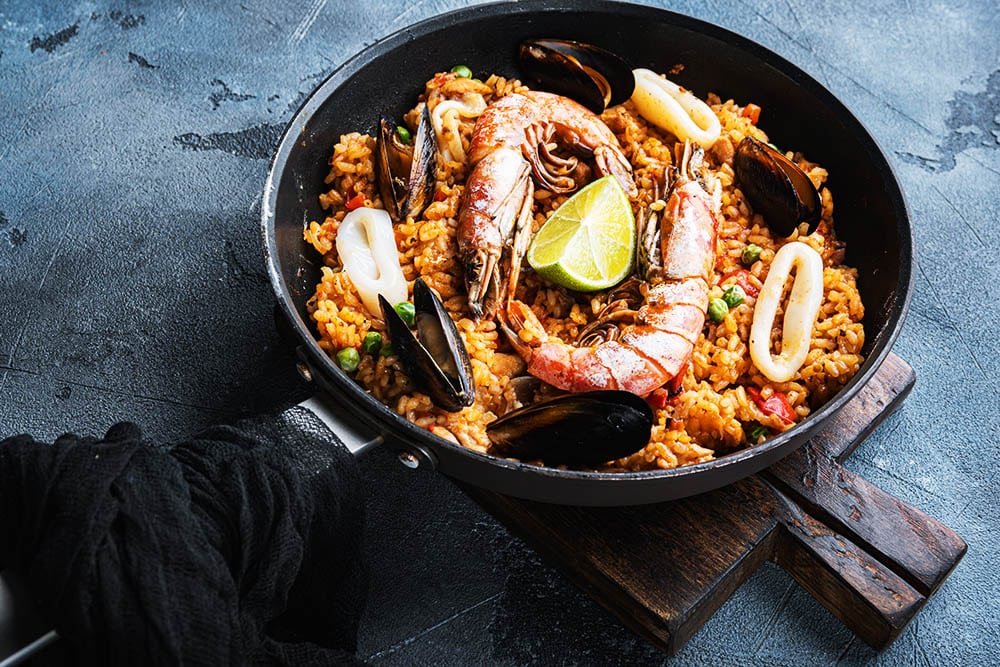When it comes to cuisine, Spain has an exceptional reputation with numerous unique and diverse culinary delights. Spaniards know how to make the most of ingredients; from fresh seafood to cured meat, to endless varieties of cheese and sweet treats. Each dish is prepared with care, attention, and passion, which is why Spanish cuisine is loved around the world. In this article, we will dive into the world of Spanish cuisine and explore the flavors, aromas, and stories behind some of the most famous Spanish dishes.
The Basics of Spanish Cuisine
Tapas: Small, Flavorful Plates
Tapas are small plates of food commonly served in Spanish bars and restaurants. They are the perfect appetizer or snack to share. A traditional Spanish meal is generally composed of several tapas, incorporating an array of flavors and ingredients. Tapas are not only a type of food, but they are also a way of life in Spain. They symbolize the art of gastronomic exploration and socializing. One of the most popular tapas is patatas bravas, which are fried potatoes topped with spicy tomato sauce.
Paella: The Iconic Rice Dish
Paella is Spain’s national dish, and it originated in Valencia. Traditional paella is a rice dish made with saffron, vegetables, seafood, or chicken. Cooking paella is considered a ritual with various techniques and methods passed down for generations. Authentic paella is cooked in a thin round pan called a paellera. It is a must-try when visiting Spain.
Jamon: The Versatile Cured Meat
Spanish Jamon (ham) is a delicacy that is more than just a cured meat. It is a symbol of Spanish culture and tradition. The most famous is Jamon Iberico de Bellota, which is made from acorn-fed pigs. This ham is intensely flavored and has a unique and distinct taste. It can be served plain or used as an ingredient in various dishes such as croquettes or tortilla.
Gazpacho: The Cold Soup
Gazpacho is a cold soup that originated in Andalucia in Southern Spain. It is a refreshing and healthy dish made primarily of tomatoes, cucumber, garlic, and peppers. The soup is served cold, making it an ideal dish for the hot Spanish summers.
Regional Specialties
The Basque Country: Pintxos and Seafood
The Basque Country is known for its incredible seafood dishes such as grilled sardines, squid in its ink, and salt cod. However, it is also famous for its pintxos, which are similar to tapas but served on a slice of bread. Pintxos are often more elaborately prepared with exotic ingredients such as foie-gras, black truffle, or tuna belly.
Andalusia: Flavorful Stews and Moorish Influences
Andalusia is the birthplace of flamenco, and it is also where you will find the flavors of Spain infused with Moorish influences. One example of this is the Andalusian stews, such as the popular Cocido Andaluz, which is made with chickpeas, chorizo, and vegetables. Other Andalusian delights include churros dipped in warm chocolate and the sweet wine, PX Sherry.
Catalonia: Michelin-Starred Restaurants and Vermouth
Catalonia is famous for its innovative and high-quality cuisine. It boasts the highest number of Michelin-Starred restaurants in Spain, making it a paradise for foodies. A unique drink in Catalonia is its vermouth, which is often enjoyed as an aperitif before lunch or dinner. Some of the most famous dishes from Catalonia include the creamy dessert of crema catalana and the savory bread with tomato, pa amb tomàquet.
Food Festivals
La Tomatina: The Tomato Throwing Festival
La Tomatina is an event that takes place in Buñol, Valencia, where participants throw tomatoes at each other for fun. The festival is held on the last Wednesday of August every year, and thousands of people participate in this colorful event.
Fiesta de San Fermin: The Running of the Bulls
The Fiesta de San Fermin, also known as the Running of the Bulls, takes place in Pamplona, Navarra, and is held annually in July. The festival attracts people from all over the world who run in front of twelve bulls through the narrow streets of the old town.
Tips for Diving into Spanish Cuisine
Try Something New
When in Spain, try something you have never had before. Embrace the local culture and flavors, and be bold with your food choices. You might be surprised by how much you love something you have never tasted before.
Be Open to Sharing
Sharing is an essential part of Spanish culture, and that extends to meals. When eating at a restaurant, consider sharing several small dishes with your fellow diners. Not only will you get to taste a variety of flavors, but it is also a great way to socialize.
Follow Tradition
To truly experience Spanish cuisine, follow tradition. From cooking methods to ingredients, Spanish cuisine is full of centuries-old techniques passed down from generation to generation. Ask your server or chef for recommendations on the traditional dishes and how they are prepared.
In conclusion, Spanish cuisine is diverse, delicious, and full of stories and traditions to discover. From the savory dishes to the sweet treats, every experience is unique and unforgettable. When in Spain, be sure to embrace the flavors, indulge in the culture, and savor every bite.
